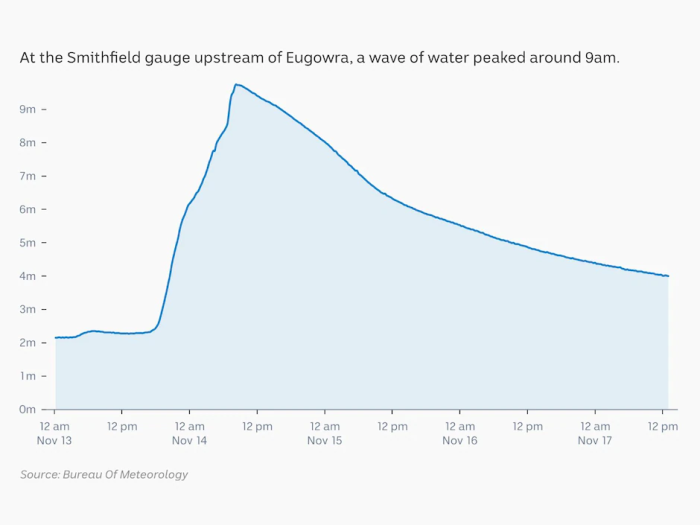- River levels peaked at a record breaking 11.2 metres after 120mmof rain on 13 November 2022.
- On November 14th 2022, Eugowra in New South Wales was hit by a devastating one-in-5000-year flash flooding event

Eugowra, a small town in the central west of New South Wales, experienced a severe flash flood in the early morning of the 14th of November. The flash flooding was caused by intense rainfall the day before, with 120mm of rain falling across the catchment on the 13th of November. This event was preceded by months of above average rainfall over south-eastern Australia. As a result, the ground was already saturated and prone to flooding.
Eugowra sits on the banks of Mandagery Creek. As floodwaters made their way downstream, the intense flash flooding occurred. The creek levels peaked at 11.2 metres, smashing the previous record of 10.01m observed in 1950. This level was higher than the town’s estimate of a one-in-5000-year flood. The flooding was so fast and large that it was called an “inland tsunami” by residents.
The heavy rainfall was caused by a deep low-pressure system which developed over Western Australia during the 11th of November. The low-pressure system intensified and affected the south-eastern parts of Australia during the 12th – 13th of November. The system caused moisture rich air to flow from tropical Australia to the southeast. When combined with uplift caused by the system, this led to heavy rainfall over southeast Australia.

This extreme flooding caused devastating consequences and enormous economic losses to the residents of Eugowra. During the flooding, 159 people were evacuated in boats and helicopters and two people lost their lives. Up to 80% of homes in the town were damaged, with some homes floating several blocks away. According to the Insurance Council of Australia, 412 insurance claims have been lodged across the region since the floods hit. The estimated cost of insured losses for Eugowra and its nearby region is at least $150m.
Main research contact: Dr Dongxia Yang | dongxia.yang@unimelb.edu.au
The State of Weather and Climate Extremes 2022
Weather and climate extremes in Antarctica
Extreme events in 2022
Heatwaves in Western Australia
Extreme rainfall and flooding in Queensland and New South Wales February-March 2022
Record low Antarctic sea ice extent in 2022
Simultaneous Antarctic and Arctic heatwaves
Collapse of East Antarctic Conger ice shelf
Hailstorms in Queensland, Victoria and New South Wales
Damaging wind gusts in South Australia and the Northern Territory
© 2023 ARC Centre of Excellence for Climate Extremes
References and acknowledgements available in the PDF version available here.
Materials used are for educational purposes and either author provided or used under fair dealing provisions.
